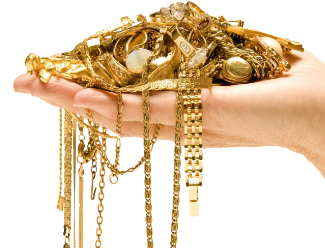Types of Gold: Yellow, White, Rose — and How They Compare


Written by:
Dave Alpert, Owner & Appraiser – specializing in gold, diamonds, jewelry, coins and precious metals. Call to set up an appointment.
When people bring in their gold—whether it’s a ring, chain, or keepsake—they often ask questions like, “Is white gold real?” or “Does rose gold have the same value as yellow gold?” These are great questions, and understanding the differences can help you make informed decisions—especially if you’re thinking about selling.
The truth is: yellow, white, and rose gold are all real gold. The differences come down to what metals are mixed with the gold, how that affects the color, and whether it has any impact on resale value.
Whether you’re trying to sell gold jewelry, identify an item’s value, or simply learn the differences between these gold types, this guide will walk you through it all.
Yellow Gold: Classic and Timeless
Yellow gold is the most traditional and recognizable form of gold. It closely resembles the color of pure 24k gold, and it’s been used for centuries in everything from fine jewelry to collectible coins.
Why choose yellow gold:
- Warm, natural color that never goes out of style
- Generally more hypoallergenic (especially in higher karats)
- Easier to resize or repair
- Common in vintage, heirloom, and high-karat jewelry
If you see a stamp like 14k or 18k on your yellow gold, it refers to the metal’s purity—not its color. For a deeper dive into those numbers, check out our Gold Purity & Hallmark Guide.
White Gold: Bright, Modern, and Popular
White gold is made by alloying pure gold with white metals like nickel, palladium, or zinc. It’s then often coated in rhodium, a rare metal that gives white gold its bright, reflective finish.
What you should know about white gold:
- Requires periodic replating to maintain shine
- Can cause skin irritation in people allergic to nickel (unless palladium is used)
- A popular choice for engagement rings and men’s jewelry
- Equal in value to yellow gold of the same karat and weight
Some people confuse white gold with platinum. They look similar—but they’re not the same metal. If you’re unsure what you have, our Gold Testing Guide walks you through quick at-home tests and explains why a professional check is still the best choice.
Rose Gold: Warm, Romantic, and Durable
Rose gold is created by mixing gold with copper, which gives it a rich, pinkish tone. It’s loved for its vintage-inspired appearance and increasing popularity in both women’s and men’s jewelry.
What makes rose gold appealing:
- Unique, romantic color
- Often stronger than yellow or white gold due to the copper alloy
- Low-maintenance—no need for rhodium plating or special care
- Popular in modern bridal jewelry and fashion pieces
Despite its trendy appearance, rose gold holds the same value as yellow or white gold at the same karat. If you’re curious about its current resale price, our Gold Buying Page explains how we evaluate every item fairly and transparently.
Green Gold: Rare and Antique
Green gold is much less common, but it does exist—especially in antique and custom-designed jewelry. It’s created by mixing gold with silver, and sometimes cadmium (in older pieces), resulting in a soft, pale greenish-yellow hue.
Fast facts about green gold:
- Rarely found in commercial jewelry today
- Sometimes used in tricolor gold pieces
- Value is still determined by purity and weight, not color
- May appear in vintage or inherited collections
If you’re not sure what type of gold you have—especially if it’s a unique color—bring it in for a free evaluation. We’ll identify it for you on the spot.
Platinum vs. White Gold: Know the Difference
We often hear customers ask, “Is this platinum or white gold?” While the two look similar, they’re completely different metals—and that difference matters.
Platinum:
- A naturally white metal (no need for rhodium plating)
- Much denser and heavier than gold
- Extremely durable and often used in high-end or luxury jewelry
- Hypoallergenic, ideal for sensitive skin
Platinum hallmarks and purity:
- Most platinum jewelry is marked “PT”, “PLAT,” or “950”
- 950 platinum means it’s 95% pure
- You may also see 900, 850, or 999, depending on the alloy and country of origin
- Unlike gold, platinum purity is usually marked in parts per thousand rather than karats
While platinum is typically more expensive per gram, resale value depends on market demand. If you suspect your piece may be platinum, we’ll test it right alongside any gold during your evaluation.
So Which Type of Gold Is the Most Valuable?
It’s a common question—and the answer is simple:
All gold types—yellow, white, rose, green—are worth the same at the same purity and weight.
What really affects resale value:
- Karat (purity level)
- Weight
- Market price at time of sale
- Condition and brand recognition
Color does not increase or decrease gold’s base value. However, it can affect demand or desirability for buyers, especially in designer jewelry.
To understand what your gold is worth today, visit our Gold Buying Page to learn how we evaluate each piece fairly and professionally.
Let Us Help You Identify and Value Your Gold
Whether your gold is white, yellow, rose, green—or you’re not even sure what you have—we’re here to help. Bring it into one of our locations for a free, no-obligation evaluation. We’ll explain the type, test its purity, and offer top dollar if you decide to sell.
📍 Visit us in Newton or Uxbridge
📞 Call ahead with questions—we’re happy to help
We buy all types of gold—and even platinum. Let’s find out what yours is really worth.
